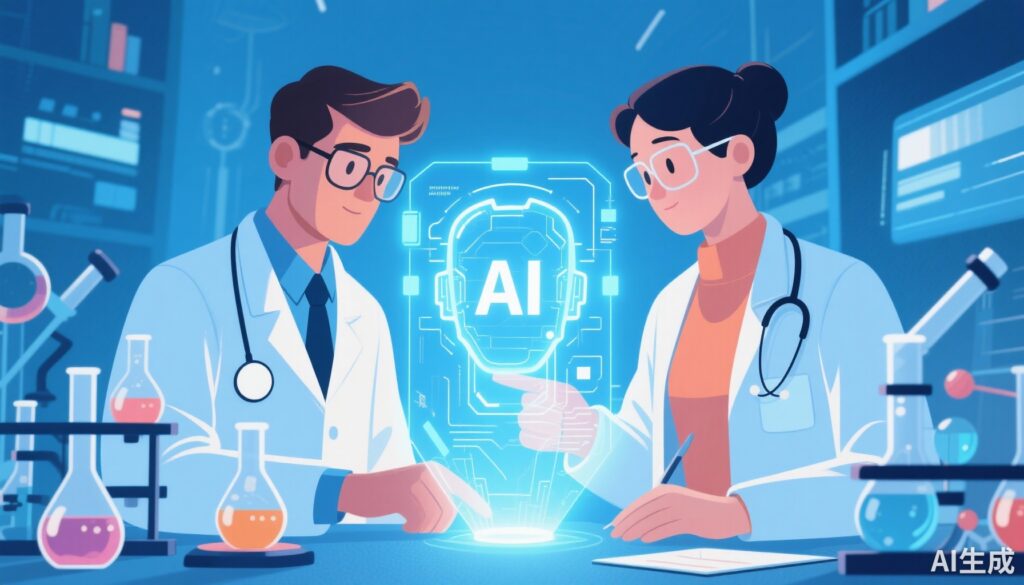Introduction: The Dawn of a New Paradigm in Life Sciences
Significant breakthroughs in life sciences have long been the bedrock supporting our understanding of the mysteries of life. Traditionally, these foundational discoveries demand years, sometimes decades, of painstaking research. But what if a powerful force could compress this prolonged journey into just a couple of days? Are we on the brink of a revolutionary shift in how scientific research is conducted?
On September 9, the journal Cell published a compelling study titled “AI mirrors experimental science to uncover a mechanism of gene transfer crucial to bacterial evolution.” This work not only solved an elusive gene transfer puzzle in bacteria but remarkably credited a unique contributor — an AI dubbed the “AI Co-scientist.” This AI, through near-independent reasoning, circumvented human cognitive biases to propose a complex biological mechanism strikingly validated by subsequent experimental results. This event invites profound reflection on the essence of discovery and creativity: how do we redefine these concepts when machines begin matching or even surpassing human insight?
A Ten-Year-Old Mystery of Bacterial “Interstellar Travel”
Imagine spotting a highly distinctive custom car in Beijing with a unique license plate, paint job, and interior. A few days later, a friend captures the very same vehicle with identical details on a street in Paris — an occurrence that seems almost impossible, unless the car had some extraordinary “teleportation” ability. Microbiologists have grappled with an analogous mystery in the microbial world.
The protagonists are genetic elements known as Phage-Inducible Chromosomal Islands (PICIs). Think of them as cunning “space pirates” residing quietly within bacterial “planets” (chromosomes). Upon detecting an invading “main fleet” —a bacteriophage (phage)—these pirates awaken, hijacking the phage’s replication systems and assembly factories to replicate themselves rapidly and fabricate their own specialized “escape pods.”
Among PICIs, a subset called capsid-forming PICIs (cf-PICIs) is particularly sophisticated: they build the main structure of their escape capsules, namely the capsid, a protein shell encapsulating their genetic cargo. However, they lack the crucial “propellers” and “landing gear” — the tail fibers of phages — necessary for infecting new bacterial “planets.”
For years, researchers believed these “pirates” operated within species or closely related bacterial strains, akin to Ferrari parts fitting only other Ferraris. Yet puzzlingly, genome sequencing revealed nearly identical cf-PICIs across distantly related species such as Escherichia coli, Klebsiella pneumoniae, and Shigella flexneri. How do they transcend such wide species barriers with such precision?
The Research Challenge: Cracking the Enigma
This conundrum confounded microbiologists for over a decade. Human research teams invested years in laborious experiments to piece together clues, eventually outlining a partial answer. Unknown to them, a new intelligent system would soon re-enact and surpass their discovery process in just two days.
A Carefully Designed “Scientific Turing Test”
Before unveiling the AI’s groundbreaking performance, it’s essential to understand the clever design behind this “test.” After years of wet lab experiments solving the cf-PICI transfer puzzle, the researchers withheld their unpublished key data and final conclusions. Instead, they handed a simplified one-page background document and some published references to their developing large language model (LLM)-based platform: the AI Co-scientist.
Unlike traditional Turing tests assessing a machine’s indistinguishability from humans in conversation, this challenge evaluated whether AI could, based only on limited information, formulate deep, original, and experimentally testable scientific hypotheses like an experienced researcher.
This approach ensured no possibility of AI “cheating” by querying external databases, as the solution did not exist in public records. It also offered a direct measurement of the AI’s hypothesis-generation capabilities by comparing its outputs to the verified experimental data.
The AI Co-Scientist System: Multi-Agent Intelligence at Work
The AI Co-scientist is a complex multi-agent setup employing several Google Gemini 2.0-based smart agents. Each agent has a distinct role: proposing initial ideas, critically assessing and challenging these ideas, searching additional resources, and ranking and optimizing hypotheses. Through iterative internal debates and self-refinements lasting hours or days—far beyond typical LLM response times—the system engages in profound “thought” beyond mere information retrieval.
Isolated from human researchers, the AI spent two days conducting a “closed-door” investigation. It then submitted a report featuring five core research directions ranked by likelihood and detailed experimental suggestions. Opening this report, human researchers found not just solutions but a mirror reflecting the constraints of human cognition alongside AI’s enormous potential.
AI’s Flash of Insight: Five Hypotheses and the “Standard Answer”
The report was structured, coherent, and insightful, akin to a senior principal investigator’s work. Its top-ranked hypothesis, “Capsid-tail interactions,” earned an Elo score of 1,777 (a measure used for assessing strategic strength). The AI reasoned that since the capsid is self-produced and conserved across different species, while host specificity is dictated by the phage tail, the capsid must possess remarkable general compatibility. It likely pairs with diverse phage tail fibers to form infectious chimeric particles, much like standardized containers hitching rides on various truck heads.
This neatly matched the human team’s years-long, soon-to-be-published findings that cf-PICIs encode adaptor and connector proteins serving as “universal adapters,” allowing capsids to hijack different phage tails and vastly expand host range.
Moreover, the AI recommended rigorous experimental plans like cryo-electron microscopy to resolve capsid-tail interfaces and targeted mutagenesis to validate key contact points, closely paralleling ongoing human research.
Beyond the primary hypothesis, four other highly plausible hypotheses emerged, all scoring above 1,700 Elo points:
– Entry Mechanisms: AI proposed alternate routes for cf-PICI spread, such as direct interactions with conserved bacterial receptors or via outer membrane vesicles, challenging the dominance of tail fiber-mediated infection.
– Integration Mechanisms: How cf-PICIs stably integrate into distinct bacterial genomes by recognizing conserved attachment sites, an idea corroborated by genomic data.
– Helper Phage and Environmental Factors: Explored roles of broad-host-range “super spreader” phages and environmental influences like antibiotics on transfer efficiency.
– Alternative Transfer and Stabilization Mechanisms: AI boldly suggested conjugation via plasmids as an overlooked route, inspiring new directions in data mining and experimental studies.
This report didn’t merely consolidate existing knowledge—it ignited fresh avenues previously unexplored by human researchers.
An AI “Showdown”: Why Only AI Co-Scientist Saw the Truth
To verify this AI’s unique capability, the team staged a competition among leading AI models, including OpenAI’s o1, Gemini 2.0 Pro, Claude Sonnet 3.7, and DeepSeek-R1, presenting all with the same problem and background.
None matched AI Co-scientist’s precision. For instance, OpenAI’s model postulated that phage tail genes were more conserved than capsid genes—a hypothesis directly opposing the truth.
Others approached the problem partially, implicating capsid-tail interactions but lacking the definitive depth and clarity of AI Co-scientist’s conclusions.
Several models even made biologically inaccurate assumptions or failed to extract core experimental insights despite access to preprint papers.
The AI Co-scientist’s triumph stemmed from its architecture simulating scientific reasoning: multi-agent debate, competition, and iterative hypothesis refinement—a “slow and deep thinking” style crucial for complex, open-ended scientific questions.
Bypassing Human Bias: AI’s Greatest Contribution to Science
What truly captivates is not just AI’s speed but its unbiased approach. The human team admitted their own research was hindered by preconceived notions rooted in textbook models that equate induction with fully infectious phage particle production. Encountering cf-PICIs induced efficiently but without cross-species transfer left them puzzled, leading to prolonged exploration down incorrect paths. They subconsciously dismissed an obvious yet counterintuitive possibility—production of tail-less, non-infectious “half-particles.”
Human experience and knowledge, while vital, can form cognitive barriers especially against disruptive innovation. AI, freed from such historical baggage, evaluates all logical paths impartially. For AI, “inducing tail-less particles” is as plausible as “generating complete particles,” allowing it to swiftly propose the key hypothesis of hijacking diverse tail fibers.
This illustrates AI’s vital potential as a cognitive “corrector” and complement in scientific research. It can uncover blind spots obscured by entrenched beliefs and propose unconventional yet logically sound hypotheses. Such human-AI collaboration promises to elevate scientific creativity and efficiency to unprecedented levels—akin to how the microscope revealed unseen microscopic worlds, AI may unveil novel realms of data-driven insight.
On the Eve of a New Scientific Paradigm
The success of the AI Co-scientist heralds an exciting, albeit challenging, new epoch in research. We are transitioning from AI as a data-processing tool to AI as a genuine “thought partner.”
Future research workflows may be transformed profoundly. Laboratories could begin their day by feeding their latest data and enigmas into an AI system, which overnight returns multiple promising hypotheses, experimental designs, and even simulated predictions. Human scientists will concentrate on posing incisive questions, evaluating AI-generated suggestions, designing clever validation experiments, and interpreting findings at philosophical depths.
Yet, this transformation raises important considerations:
– Hypothesis Inflation: The low cost of AI-generated hypotheses may overwhelm validation capabilities, demanding efficient screening mechanisms.
– Intellectual Property and Authorship: When AI contributes core ideas, how to attribute credit fairly? Should AI hold intellectual property rights? How must academic reward systems evolve for human-AI co-created science?
– Dependence Risks: Could reliance on AI hinder the development of researchers’ independent creativity, intuition, and interdisciplinary integration?
– The “Black Box” Problem: AI’s reasoning remains opaque. Ensuring conclusions are causally sound rather than correlations extracted from data requires enhancing transparency and explainability.
The Cell publication stands as a clarion call initiating a “human-machine collaborative” race in scientific discovery. It demonstrates AI’s prowess not only in solving specific biological puzzles but also as a powerful creativity engine. The story is still unfolding; AI Co-scientist and its successors won’t replace human researchers but will fundamentally reshape our exploration of the unknown.
In the future, the temple of science will no longer be lit solely by human intellect but will shine brilliantly combining human intuition, curiosity, and profound insights with AI’s relentless computation, unbiased logic, and formidable creativity. Together, this partnership will compose a grander chapter exploring the cosmos and life’s secrets.
And fortunately, we stand at the dawn of this epoch, witnessing history in the making.
References
https://www.cell.com/cell/fulltext/S0092-8674(25)00973-0



